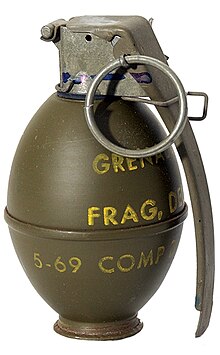
Back Fragging (Militär) German Fragging Spanish Fragging Finnish Fragging French Fragging Italian 프래깅 Korean Fragging Polish Фрэггинг Russian Fraggning Swedish Фрегінг Ukrainian

Fragging is the deliberate or attempted killing of a soldier, usually a superior, by a fellow soldier. U.S. military personnel coined the word during the Vietnam War, when such killings were most often committed or attempted with a fragmentation grenade,[2] to make it appear that the killing was accidental or during combat with the enemy. The term fragging now encompasses any deliberate killing of military colleagues.[3][4]
The high number of fragging incidents in the latter years of the Vietnam War was symptomatic of the unpopularity of the war with the American public and the breakdown of discipline in the U.S. Armed Forces. Documented and suspected fragging incidents using explosives totaled 904 from 1969 to 1972,[5] while hundreds of fragging incidents using firearms took place, but were hard to quantify as they were indistinguishable from combat deaths and poorly documented.
Fragging should not be confused with the unintentional killing and/or wounding of comrades and/or allied personnel; such incidents are referred to as friendly fire.
- ^ Military historian examines Vietnam-era fragging cases— including details of many that may never be resolved Archived December 26, 2013, at the Wayback Machine Texas Tech University Press, May 16, 2001
- ^ "Frag". www.oxfordlearnersdictionaries.com. Retrieved June 21, 2021.
- ^ William Darryl Henderson (1999). Chambers, John Whiteclay (ed.). The Oxford companion to American military history. Oxford University Press. p. 279. ISBN 978-0-19-507198-6.
- ^ William Darryl Henderson. "Fragging | Encyclopedia.com". www.encyclopedia.com.
- ^ Cite error: The named reference
Leprewas invoked but never defined (see the help page).
© MMXXIII Rich X Search. We shall prevail. All rights reserved. Rich X Search